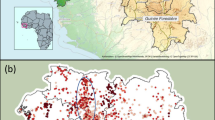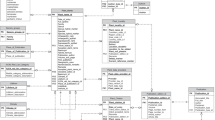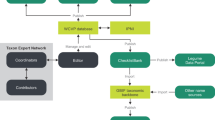Abstract
New Guinea is the world’s largest tropical island and has fascinated naturalists for centuries1,2. Home to some of the best-preserved ecosystems on the planet3 and to intact ecological gradients—from mangroves to tropical alpine grasslands—that are unmatched in the Asia-Pacific region4,5, it is a globally recognized centre of biological and cultural diversity6,7. So far, however, there has been no attempt to critically catalogue the entire vascular plant diversity of New Guinea. Here we present the first, to our knowledge, expert-verified checklist of the vascular plants of mainland New Guinea and surrounding islands. Our publicly available checklist includes 13,634 species (68% endemic), 1,742 genera and 264 families—suggesting that New Guinea is the most floristically diverse island in the world. Expert knowledge is essential for building checklists in the digital era: reliance on online taxonomic resources alone would have inflated species counts by 22%. Species discovery shows no sign of levelling off, and we discuss steps to accelerate botanical research in the ‘Last Unknown’8.
This is a preview of subscription content, access via your institution
Access options
Access Nature and 54 other Nature Portfolio journals
Get Nature+, our best-value online-access subscription
$29.99 / 30 days
cancel any time
Subscribe to this journal
Receive 51 print issues and online access
$199.00 per year
only $3.90 per issue
Buy this article
- Purchase on Springer Link
- Instant access to full article PDF
Prices may be subject to local taxes which are calculated during checkout




Similar content being viewed by others
Code availability
The R code used for calculations and analyses is available from the corresponding author on request.
References
Frodin, D. in The Ecology of Papua, Part One (eds Marshall, A. & Beehler, B.) 87–130 (Periplus, 2007).
Conn, B. J. in Biodiversity and Terrestrial Ecosystems (eds Peng, C.-I. & Chou, C.-H.) 123–156 (Institute of Botany, Academia Sinica, 1994).
Mittermeier, R. A. et al. Biodiversity hotspots and major tropical wilderness areas: approaches to setting conservation priorities. Conserv. Biol. 12, 516–520 (1998).
Paijmans, K. New Guinea Vegetation (Commonwealth Scientific and Industrial Research Organization in association with the Australian National Univ. Press, 1976).
Roos, M. C. et al. Species diversity and endemism of five major Malesian islands: diversity–area relationships. J. Biogeogr. 31, 1893–1908 (2004).
Loh, J. & Harmon, D. A global index of biocultural diversity. Ecol. Indic. 5, 231–241 (2005).
Cámara-Leret, R. & Dennehy, Z. Information gaps of indigenous and local knowledge for science-policy assessments. Nat. Sustain. 2, 736–741 (2019).
Souter, G. New Guinea: The Last Unknown (Angus and Robertson, 1963).
Good, R. On the geographical relationships of the angiosperm flora of New Guinea. Bull. Br. Mus. Nat. Hist. 2, 205–226 (1960).
Supriatna, J. et al. The Irian Jaya Biodiversity Conservation Priority-Setting Workshop (Conservation International, 1999).
Madagascar Catalogue. Catalogue of the Plants of Madagascar (Missouri Botanical Garden, St Louis, USA, accessed August 2019); http://www.tropicos.org/Project/Madagascar
Backer, C. A. & Bakhuizen van den Brink, R. C. Jr. Flora of Java Vol. 1–3 (Wolters Noordhoff, 1968).
Pelser, P. B., Barcelona, J. F. & Nickrent, D. L. (eds) Co’s Digital Flora of the Philippines (accessed August 2019); www.philippineplants.org
MacArthur, R. H. & Wilson, E. O. The Theory of Island Biogeography (Princeton Univ. Press, 1967).
Webb, C. O., Slik, J. F. & Triono, T. Biodiversity inventory and informatics in Southeast Asia. Biodivers. Conserv. 19, 955–972 (2010).
Hoover, J. D. et al. Modeling hotspots of plant diversity in New Guinea. Trop. Ecol. 58, 623–640 (2017).
Ulloa Ulloa, C. et al. An integrated assessment of the vascular plant species of the Americas. Science 358, 1614–1617 (2017).
van Welzen, P. C., Slik, J. W. F. & Alahuhta, J. Plant distributions and plate tectonics in Malesia. Biologiske Skrifter 55, 199–217 (2005).
Baldwin, S. L., Fitzgerald, P. G. & Webb, L. E. Tectonics of the New Guinea region. Annu. Rev. Earth Planet. Sci. 40, 495–520 (2012).
Steinbauer, M. J. Topography-driven isolation, speciation and a global increase of endemism with elevation. Glob. Ecol. Biogeogr. 25, 1097–1107 (2016).
ter Steege, H. et al. Towards a dynamic list of Amazonian tree species. Sci. Rep. 9, 3501 (2019).
van Steenis, C. G. G. J. (ed.) Flora Malesiana series I Vol. I (Noordhoff-Kolff, 1950).
Boyle, B. et al. The taxonomic name resolution service: an online tool for automated standardization of plant names. BMC Bioinformatics 14, 16 (2013).
Lamanna, C. et al. Functional trait space and the latitudinal diversity gradient. Proc. Natl Acad. Sci. USA 111, 13745–13750 (2014).
ter Steege, H. et al. The discovery of the Amazonian tree flora with an updated checklist of all known tree taxa. Sci. Rep. 6, 29549 (2016).
Cardoso, D. et al. Amazon plant diversity revealed by a taxonomically verified species list. Proc. Natl Acad. Sci. USA 114, 10695–10700 (2017).
Coode, M. J. E., Hinchcliffe, S. C. & Marsden, C. J. Checklist of the Flowering Plants of N. E. Kepala Burung (Vogelkop), Irian Jaya, Indonesia (Royal Botanic Gardens, Kew, 1997).
Basset, Y. et al. Quantifying biodiversity: experience with parataxonomists and digital photography in Papua New Guinea and Guyana. Bioscience 50, 899–908 (2000).
Goodwin, Z. A., Harris, D. J., Filer, D., Wood, J. R. & Scotland, R. W. Widespread mistaken identity in tropical plant collections. Curr. Biol. 25, R1066–R1067 (2015).
Goss, A. The Floracrats: State-Sponsored Science and the Failure of the Enlightenment in Indonesia (Univ. Wisconsin Press, 2011).
Conn, B. J. & Damas, K. Q. Trees of Papua New Guinea Vol. 1–3 (Xlibris, 2019).
Newman, M., Chayamarit, K. & Balslev, H. in Tropical Plant Collections: Legacies from the Past? Essential Tools for the Future (eds Friis, I. & Balslev, H.) 177–186 (Royal Danish Academy of Sciences and Letters, 2017).
Cámara-Leret, R. et al. The Manokwari Declaration: challenges ahead in conserving 70% of Tanah Papua’s forests. Forest Soc. 3, 148–151 (2019).
APG IV. An update of the Angiosperm Phylogeny Group classification for the orders and families of flowering plants: APG IV. Bot. J. Linn. Soc. 181, 1–20 (2016).
Pteridophyte Phylogeny Group. A community-derived classification for extant lycophytes and ferns. J. Syst. Evol. 54, 563–603 (2016).
Christenhusz, M. J. et al. A new classification and linear sequence of extant gymnosperms. Phytotaxa 19, 55–70 (2011).
R Core Team. R: a language and environment for statistical computing (R Foundation for Statistical Computing, 2019).
Hijmans, R. & van Etten, J. raster: Geographic data analysis and modeling. R package v.2.8-19. https://cran.r-project.org/web/packages/raster/index.html (2019).
Vilela, B. & Villalobos, F. letsR: a new R package for data handling and analysis in macroecology. Methods Ecol. Evol. 6, 1229–1234 (2015).
QGIS Development Team. QGIS: a Free and Open Source Geographic Information System. http://qgis.osgeo.org (2020).
Acknowledgements
We thank the collectors, herbarium and database curators and colleagues at our institutions for support and discussions; J. Bascompte for feedback on a previous draft; and I. Cámara Leret for the design of Fig. 3. R.C.-L. and P.C.v.W. received funding from the Royal Society International Exchanges (grant IE 170241, ‘Building the New Guinea Research Team’); A.S.B. acknowledges financial support from the Carlsberg Foundation and the Danish Research Council; L.-F.F. acknowledges the National Natural Science Foundation of China (grant 31570307); G.H. acknowledges the Conselho Nacional de Desenvolvimento Científico e Tecnológico (CNPq) for a post-doctoral fellowship (process 153430/2018-4); S.K. was supported by the US National Science Foundation (grant DEB-1457366); Y.W.L is funded by the National Parks Board, Singapore under a postgraduate research scholarship; M.L. received funding from the Deutsche Forschungsgemeinschaft (LE 1826/3-1) and Synthesys (GB-TAF-6305); P.H.A.M. acknowledges the São Paulo Research Foundation – FAPESP (grant 2015/13112-7 and 2018/09379-6); D.S.P. received funding from the US National Science Foundation (grant DEB-1754667); the contributions of G.D.W. to the project were supported by the US National Science Foundation (grants DEB-0515678, DEB-0816749 and DEB-0841885); and M.H. and H.P.W. received funding from the Edinburgh Botanic Garden (Sibbald) Trust and the M. L. MacIntyre Begonia Trust. The Royal Botanic Garden Edinburgh is supported by the Scottish Government’s Rural and Environmental Science and Analytical Services Division.
Author information
Authors and Affiliations
Contributions
R.C.-L. conceived the study, analysed the data and wrote a first draft of the paper. All authors verified taxonomic data and contributed to revisions.
Corresponding author
Ethics declarations
Competing interests
The authors declare no competing interests.
Additional information
Peer review information Nature thanks Timothy Baker, Lars Chatrou, Thomas Givnish, Vojtech Novotny and Hans ter Steege for their contribution to the peer review of this work.
Publisher’s note Springer Nature remains neutral with regard to jurisdictional claims in published maps and institutional affiliations.
Extended data figures and tables
Extended Data Fig. 1 Delimitation of the study area of New Guinea.
The study area (black islands) includes islands within a depth of −120 m of mainland New Guinea according to the General Bathymetric Chart of the Oceans (http://www.gebco.net). Purple lines depict seafloor depth starting at −120 m.
Extended Data Fig. 2 Collection effort and discovery of the New Guinea flora through time.
The number of plant collections that have been digitized (green bars), the cumulative total number of collections (green dotted line) and the cumulative number of plant species (basionyms) described over time (black dotted line).
Supplementary information
Supplementary Table 1
Checklist of the Vascular Plants of New Guinea.
Supplementary Table 2
Synonyms of Vascular Plants in New Guinea.
Supplementary Table 3
State of knowledge and dates of coverage of vascular plants in New Guinea since 1905.
Supplementary Table 4
State of knowledge of larger (≥ 40 spp.) vascular plant genera in New Guinea.
Rights and permissions
About this article
Cite this article
Cámara-Leret, R., Frodin, D.G., Adema, F. et al. New Guinea has the world’s richest island flora. Nature 584, 579–583 (2020). https://doi.org/10.1038/s41586-020-2549-5
Received:
Accepted:
Published:
Issue Date:
DOI: https://doi.org/10.1038/s41586-020-2549-5
This article is cited by
-
An Annotated Checklist of Cyrtandra, Cyrtandropsis and Sepikea (Gesneriaceae) in New Guinea
Kew Bulletin (2024)
-
The naturalized vascular flora of Malesia
Biological Invasions (2023)
-
Global Plant Ecology of Tropical Ultramafic Ecosystems
The Botanical Review (2023)
-
A Taxonomically-verified and Vouchered Checklist of the Vascular Plants of the Republic of Guinea
Scientific Data (2023)
-
Melanesia holds the world’s most diverse and intact insular amphibian fauna
Communications Biology (2022)
Comments
By submitting a comment you agree to abide by our Terms and Community Guidelines. If you find something abusive or that does not comply with our terms or guidelines please flag it as inappropriate.



